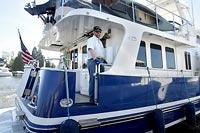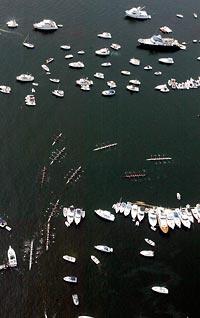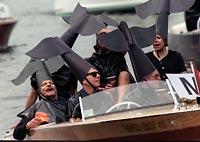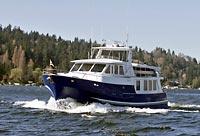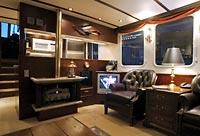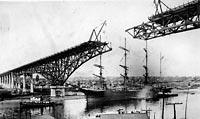Seattle parades its boating mania on season's opening day

It's hard to say when the bug bit Steve Hazlerig.
It could have been back when he helped his dad build a plywood rowboat to float on Missouri's Lake Pomme de Terre. Or maybe it was years later, when he bought the Bayliner, or the 42-foot Hunter sailboat.
But his affliction was obvious in the worst way by 2001, when he could look out from his new home on a canal in Bellevue and see three large powerboats and a sailboat — all of them his.
"It was out of control," Hazlerig said recently as he motored some friends around lakes Union and Washington. "I had about 300 lineal feet of boats."
Come Saturday, Hazlerig will be in good company, navigating his 58-foot trawler, Solara, through the Montlake Cut with several hundred other certified boat nuts in the Seattle Yacht Club's annual Opening Day parade.
The 86-year tradition is one of the most outlandish on water, a festival of rowing shells, dueling pirates, captain's braids, white pants, blue blazers, marching bands afloat, varnish, diesel, spinnakers and a log boom lined with thousands of boaters reveling in the Boater's New Year. An authority no less than the editorial page of this newspaper has called it "the true celebration of life on Puget Sound."
And at countless tillers, wheels and lines will be so many people who, like Hazlerig, are just a little obsessed.
Boating invites obsession, more so on Lt. Peter Puget's sound. Water courses through our landscape, culture and history. To the smitten, the whole area can start to look like one big boat festival.
We're awash in boats
Boating here goes back several thousand years, with local natives plying the waters in massive, hand-carved cedar canoes. The first white settlers arrived on the schooner Exact. Word of gold in Alaska came on the schooner Portland. Blakely Harbor, a quiet cove on the east side of Bainbridge Island, was once home to the Hall Brothers shipyard, which turned out 77 wooden ships.
The end of the age of sail here is typified by the picture of the three-masted Monongahela passing under the Aurora Bridge before it was completed in the early 1930s, but the car did not completely replace the boat.
There are now roughly 230,000 powerboats, sailboats, kayaks and canoes sprinkled around the region. According to market research obtained by The Seattle Times, more than one in 10 adults live in boat-owning households.
That's not the highest percentage of any region, a common claim around here, but it is the ninth most boat-happy region in the country. (Spokane is first, followed by Fort Myers, Fla.; Minneapolis; and Grand Rapids, Mich.)
In the past few years, total boat sales in the state have been as high as $721 million. That's bigger than the state's wheat crop.
The regional boat frenzy has also reached new lengths as area boat builders have turned Western Washington into what the Puget Sound Business Journal calls "the epicenter of superyacht construction in North America." Westport Shipyard; Christensen Shipyards in Vancouver, Wash.; and Northern Marine in Anacortes can all claim to have built boats of more than 150 feet, which is really more ship- than boat-sized.
Delta Marine Industries in Seattle recently launched the megayacht Laurel, which at 240 feet is the largest built in North America in 75 years.
Paul Allen's 413-foot Octopus briefly held the title of world's biggest yacht, before Oracle founder Larry Ellison and the ruler of Dubai got bigger boats.
Ships of dreams
Hazlerig, an alumnus of the same software company that Allen co-founded, has a relatively humble fleet: the Delta-built Solara, a few tenders, a 20-foot Italian-style retro speedboat, a couple of boats in a garage and a 20-foot sailboat.
"That's the boat I bought so I could sell the big sailboat," Hazlerig said.
The very notion of an obsession defies rational explanation. It's emotional, so why should it be rational?
But let's at least try to break this down into some of its elements, the foremost being all that water.
"This is such a great boating area," said Hazlerig. "People who don't boat, and even some people who do, don't realize how lucky we are to be right here."
Puget Sound's wily currents are known around the world, but it also has more than 2,000 miles of well-sheltered shoreline and several hundred islands.
"It's protected, but it's interesting," said Hazlerig. "You can get out in the wilds."
Or the rest of the world. Eleven years ago, Doug Fryer went out the Strait of Juan de Fuca in a 42-foot cutter designed by Seattle's own Robert Perry for a counter-clockwise circumnavigation of South America. Susan Kruller, a fellow Seattle Yacht Club member, met the boat for the trip around Cape Horn, the Mount Everest of sailing.
She saw wind strong enough to turn water to foam and bend an anemometer 90 degrees, from a helicopter to a propeller. They followed the route Charles Darwin described in "The Voyage of the Beagle," reading along as they went.
"It was wonderful," she said.
Another of boating's major elements: boats. No single boat can do everything; they're all compromises. But for the truly smitten, almost all boats can serve as dream machines.
A kayak can be the key to a beach-hopping trip in the San Juans. A dory can take you to Alaska, as one did for retirees Pete and Nancy Ashenfelter in 1983.
Bobbi Schmitz Campbell crews on a 68-foot sailboat and owns her father's 28-foot Chris Craft powerboat. When she had breast cancer in 2002, she would regularly ask her oncologist, a sailor, when she would once again grind a winch.
But one of the boats dearest to her heart is the Penn Yan dinghy she keeps in her garage. It is a talisman from her youth, similar to the boat her mother put her in for an old black-and-white taken when she was 2. There she is in a bonnet and swimsuit, with Hood Canal in the background.
"At work, they finally understood where I was coming from when I brought in this picture," she said.
Sense in a watery world
Yet another element of boating: all the nonboating stuff — the noise of modern living, the mass of men leading lives of quiet desperation, relentlessness of yard work, the boss, traffic.
"Part of it is just being master of your environment, controlling your environment and getting out away from everything," said Hazlerig. Solara was heading east on Lake Union. High overhead, commuters were slogging homeward on the Ship Canal Bridge.
"Even now, in the middle of the city, we're in our own little world. When you travel, it's a great way to experience the Northwest because you get to go to all these places with a maritime background. To be able to travel on your own power is pretty neat."
It's an intriguing thought, that an entire world might be circumscribed by a boat's gunwales. Solara does that in spades, with enough systems for navigation, electricity and plumbing to be its own on-board utility.
A boat contains another world, too, of traditions, customs and a language all its own. Some of this knowledge is arcane and even suspect, like the notion that the expression "hunky-dory" comes from a street in the waterfront district of Yokohama, Japan, where a sailor could find most anything he desired.
Some of this knowledge is handy enough to save your life, like remembering to put out a ladder if you are the last one taking a dip off the boat.
Some of it is just convenient, like remembering to replace the drain plug before sliding the skiff off the trailer.
You can spend a lifetime learning this stuff and messing with it and striving for some sort of mastery.
As much as anything, that's what gets celebrated on Opening Day. Sure, everyone's blowing off steam and eccentricity and excitement over the chance to whip around the lake in dry weather (this year's theme: Caribbean Carnival).
But watch closely, and you'll see Hazlerig working Solara with seven or so other boats, snappily maneuvering about in a disciplined bid for the Wilson Seamanship Trophy.
It's part of a massive effort to do things in accordance with some sort of maritime protocol. By-the-book restorations, consistent attire, the proper use of nautical flags, the right salute, fleet spacing, blindingly buffed varnish will all be on display and quite often judged as 18 trophies and even more plaques come into play.
It may seem like some sort of crazy aquatic cotillion, but in this watery world, it all starts to make perfect sense.
Seattle Times researcher Gene Balk contributed to this story.
